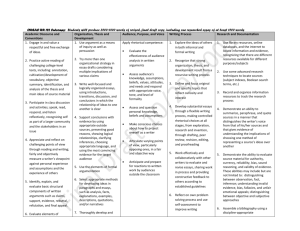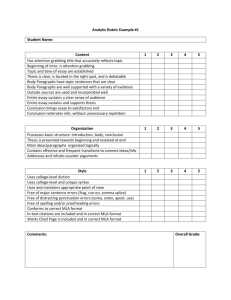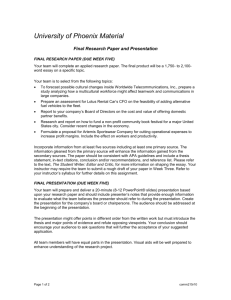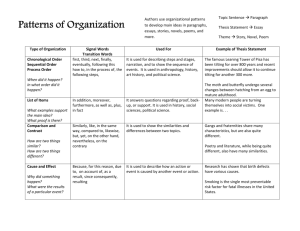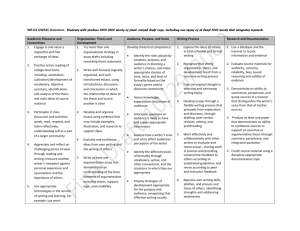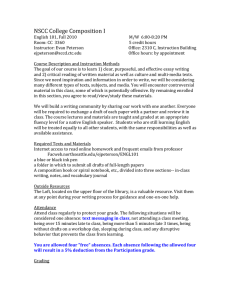OWEAC_Outcomes_WR115_9-2-09
advertisement
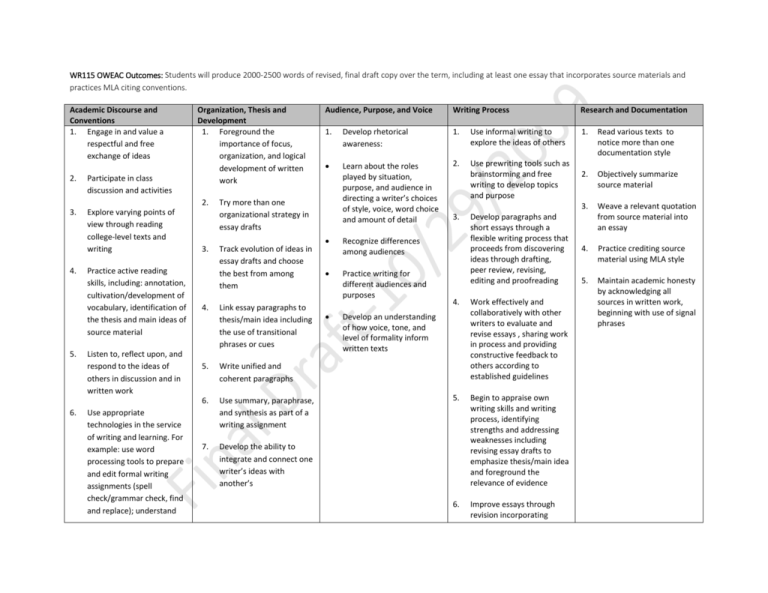
WR115 OWEAC Outcomes: Students will produce 2000-2500 words of revised, final draft copy over the term, including at least one essay that incorporates source materials and practices MLA citing conventions. Academic Discourse and Conventions 1. Engage in and value a respectful and free exchange of ideas 2. Participate in class discussion and activities 3. Explore varying points of view through reading college-level texts and writing Organization, Thesis and Development 1. Foreground the importance of focus, organization, and logical development of written work 2. 4. 5. 6. Practice active reading skills, including: annotation, cultivation/development of vocabulary, identification of the thesis and main ideas of source material Listen to, reflect upon, and respond to the ideas of others in discussion and in written work Use appropriate technologies in the service of writing and learning. For example: use word processing tools to prepare and edit formal writing assignments (spell check/grammar check, find and replace); understand 3. 4. Audience, Purpose, and Voice Writing Process Research and Documentation 1. Develop rhetorical awareness: 1. Use informal writing to explore the ideas of others 1. Read various texts to notice more than one documentation style Learn about the roles played by situation, purpose, and audience in directing a writer’s choices of style, voice, word choice and amount of detail 2. Use prewriting tools such as brainstorming and free writing to develop topics and purpose 2. Objectively summarize source material 3. Weave a relevant quotation from source material into an essay 4. Practice crediting source material using MLA style 5. Maintain academic honesty by acknowledging all sources in written work, beginning with use of signal phrases Try more than one organizational strategy in essay drafts Track evolution of ideas in essay drafts and choose the best from among them Link essay paragraphs to thesis/main idea including the use of transitional phrases or cues 5. Write unified and coherent paragraphs 6. Use summary, paraphrase, and synthesis as part of a writing assignment 7. Develop the ability to integrate and connect one writer’s ideas with another’s Recognize differences among audiences Practice writing for different audiences and purposes 3. Develop paragraphs and short essays through a flexible writing process that proceeds from discovering ideas through drafting, peer review, revising, editing and proofreading 4. Work effectively and collaboratively with other writers to evaluate and revise essays , sharing work in process and providing constructive feedback to others according to established guidelines 5. Begin to appraise own writing skills and writing process, identifying strengths and addressing weaknesses including revising essay drafts to emphasize thesis/main idea and foreground the relevance of evidence 6. Improve essays through revision incorporating Develop an understanding of how voice, tone, and level of formality inform written texts the limitations of such tools; locate course materials and resources online; and use online communication tools such as e-mail 7. Practice using Edited Standard Written English to address an academic audience 8. Gain familiarity with the uses of a writer's handbook and/or other resources instructor feedback 7. Discover available writing assistance/resources


